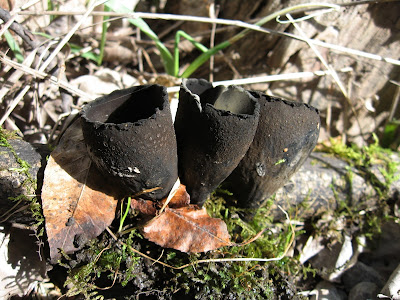As a rule late summer and autumn are the optimal seasons to go hunting for fungi, but some species produce their fruitbodies in spring and summer. Discovered by a friend along the edge of a swamp bordering Lost Channel Road in early May, this distinctive fungus also has a rather unusual name – Devil's Urn. One has to wonder about the history or derivation of certain fungus names ... Toadstool, Dead Man's Fingers, Witches' Butter ... at least the binomial or Latin name of this Ascomycete (the group that also includes cup fungi, saddles, morels, et al), Urnula craterium, is scrutable.
Friday, May 10, 2013
Springtime 'Shrooms
Although it's obviously a Coprinoid or Inky Cap, as of now I cannot assign a specific name to this mushroom growing from the soil near the base of my Gaillardias. (Edit ... possibly Coprinopsis lagopus a.k.a. Hare's Foot Inkcap?)
Looking like something from out of this world, an immature Dryad's Saddle (Polyporus squamosus) sprouts from a dead tree stump near the walking bridge in Tweed. Eye-catching groups of this large – up to 30 cm in diameter – fungus can be found on both dead wood and living trees throughout the summer and into autumn.
Even more strange and weird and otherwordly in appearance are the spore producing tentacle-like growths of Cedar-Apple Rust (Gymnosporangium juniperi-virginianae). This fungus has a complex life cycle, alternating between Apple and Eastern Red Cedar as host plants.
Another late spring fungus often encountered along the trans-Canada Trail (several specimens were found a few kilometers east of Sulphide) is Morchella elata, a.k.a. the Black Morel. The conical cap and relatively deep pits distinctly outlined in black distinguish this fungus from other species of Morchella.
Labels:
Black Morel,
Cedar-Apple Rust,
Devil's Urn,
Dryad's Saddle,
Fungi,
Inky Cap










